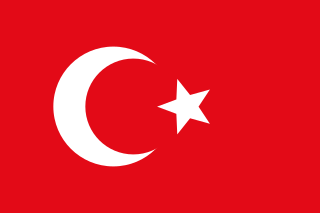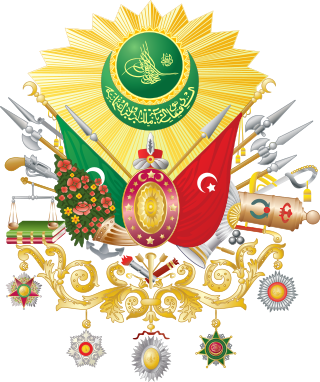
The Balkans, corresponding partially with the Balkan Peninsula, is a geographical area in southeastern Europe with various geographical and historical definitions. The region takes its name from the Balkan Mountains that stretch throughout the whole of Bulgaria. The Balkan Peninsula is bordered by the Adriatic Sea in the northwest, the Ionian Sea in the southwest, the Aegean Sea in the south, the Turkish straits in the east, and the Black Sea in the northeast. The northern border of the peninsula is variously defined. The highest point of the Balkans is Musala, 2,925 metres (9,596 ft), in the Rila mountain range, Bulgaria.

Mehmed II, commonly known as Mehmed the Conqueror, was twice the sultan of the Ottoman Empire from August 1444 to September 1446 and then later from February 1451 to May 1481.

The Ottoman Empire, also called the Turkish Empire, was an imperial realm that controlled much of Southeast Europe, West Asia, and North Africa from the 14th to early 20th centuries; it also controlled parts of southeastern Central Europe, between the early 16th and early 18th centuries.

Bosnia and Herzegovina is a country in Southeast Europe on the Balkan Peninsula. It has had permanent settlement since the Neolithic Age. By the early historical period it was inhabited by Illyrians and Celts. Christianity arrived in the 1st century, and by the 4th century the area became part of the Western Roman Empire. Germanic tribes invaded soon after, followed by Slavs in the 6th century.

The Treaty of Passarowitz, or Treaty of Požarevac, was the peace treaty signed in Požarevac, a town that was in the Ottoman Empire but is now in Serbia, on 21 July 1718 between the Ottoman Empire and its adversaries, the Habsburg monarchy and the Republic of Venice.

The Treaty of Berlin was signed on 13 July 1878. In the aftermath of the Russian victory against the Ottoman Empire in the Russo-Turkish War of 1877–1878, the major powers restructured the map of the Balkan region. They reversed some of the extreme gains claimed by Russia in the preliminary Treaty of San Stefano, but the Ottomans lost their major holdings in Europe. It was one of three major peace agreements in the period after the 1815 Congress of Vienna. It was the final act of the Congress of Berlin and included the United Kingdom, Austria-Hungary, France, Germany, Italy, Russia and the Ottoman Empire. Chancellor of Germany Otto von Bismarck was the chairman and dominant personality.

Rumelia was the name of a historical region in Southeastern Europe that was administered by the Ottoman Empire, roughly corresponding to the Balkans. In its wider sense, it was used to refer to all Ottoman possessions and vassals in Europe. These would later be geopolitically classified as "the Balkans", although Hungary, Moldova and Slovakia are often excluded. During the period of its existence, Rumelia was more often known in English as Turkey in Europe.

The Ottoman Empire was founded c. 1299 by Osman I as a small beylik in northwestern Asia Minor just south of the Byzantine capital Constantinople. In 1326, the Ottomans captured nearby Bursa, cutting off Asia Minor from Byzantine control. The Ottomans first crossed into Europe in 1352, establishing a permanent settlement at Çimpe Castle on the Dardanelles in 1354 and moving their capital to Edirne (Adrianople) in 1369. At the same time, the numerous small Turkic states in Asia Minor were assimilated into the budding Ottoman sultanate through conquest or declarations of allegiance.

A series of military conflicts between the Ottoman Empire and various European states took place from the Late Middle Ages up through the early 20th century. The earliest conflicts began during the Byzantine–Ottoman wars, waged in Anatolia in the late 13th century before entering Europe in the mid-14th century with the Bulgarian–Ottoman wars. The mid-15th century saw the Serbian–Ottoman wars and the Albanian-Ottoman wars. Much of this period was characterized by the Ottoman expansion into the Balkans. The Ottoman Empire made further inroads into Central Europe in the 15th and 16th centuries, culminating in the peak of Ottoman territorial claims in Europe.

The Bosnian Crisis, also known as the Annexation Crisis or the First Balkan Crisis, erupted on 5 October 1908 when Austria-Hungary announced the annexation of Bosnia and Herzegovina, territories formerly within the sovereignty of the Ottoman Empire but under Austro-Hungarian administration since 1878.

The Battle of Sisak was fought on 22 June 1593 between Ottoman Bosnian forces and a combined Christian army from the Habsburg lands, mainly the Kingdom of Croatia and Inner Austria. The battle took place at Sisak, central Croatia, at the confluence of the Sava and Kupa rivers, on the borderland between Christian Europe and the Ottoman Empire.

Omer Pasha, also known as Omer Pasha Latas was an Ottoman field marshal and governor. Born in the Austrian Empire to Serbian Orthodox Christian parents, he initially served as an Austrian soldier. When faced with charges of embezzlement, he fled to Ottoman Bosnia in 1823 and converted to Islam; he then joined the Ottoman army, where he quickly rose through the ranks. Latas crushed several rebellions all across the Ottoman Empire. He served as the main commander of the Crimean War, where he defeated the Russians at Giurgevo, regaining control of Bucharest and the Danubian Principalities, pushing the Russians outside of the Danube. Latas spearheaded notable victories at Oltenița, Cetate, Eupatoria, Sukhumi, and Sevastopol. As a commander, he was noted for his excellent strategic and diplomatic skills.

The Ottoman Empire era of rule in Bosnia and Herzegovina and Herzegovina lasted from 1463/1482 to 1908.

İbrahim Peçevi or Peçuyli İbrahim Efendi or (in Bosnian)Ibrahim Alajbegović Pečevija (1572–1650) was an Ottoman Bosnian historian-chronicler of the Ottoman Empire.

The Austro-Turkish War was fought in 1788–1791 between the Habsburg monarchy and the Ottoman Empire, concomitantly with the Russo-Turkish War (1787–1792). It is sometimes referred to as the Habsburg–Ottoman War or the Austro-Ottoman War.

The Turks in Bosnia and Herzegovina also referred to as Bosnian Turks, are ethnic Turks who form the oldest ethnic minority in Bosnia and Herzegovina. The Turkish community began to settle in the region in the 15th century under Ottoman rule, however, many Turks immigrated to Turkey when Bosnia and Herzegovina came under Austro-Hungarian rule.

Chiflik, or chiftlik, is a Turkish term for a system of land management in the Ottoman Empire. Before the chiflik system the Empire used a non-hereditary form of land management called the timar system. As the Empire began to collapse, powerful military officers started to claim land from the sultan's holding allowing them to pass the land onto their sons, thus creating the chiflik system. This form of land management lasted from the 16th century until the collapse of the Ottoman Empire in 1919.
A kadiluk was the jurisdiction of a kadi, an Islamic judge under the Ottoman Empire. They typically consisted of a major city and its surrounding villages, although some kadis occupied other positions within the imperial administration.
Taxation in the Ottoman Empire changed drastically over time, and was a complex patchwork of different taxes, exemptions, and local customs.

During the decline and dissolution of the Ottoman Empire, Muslim inhabitants living in Muslim-minority territories previously under Ottoman control often found themselves persecuted after borders were re-drawn. These populations were subject to genocide, expropriation, massacres, religious persecution, mass rape, and ethnic cleansing.


















